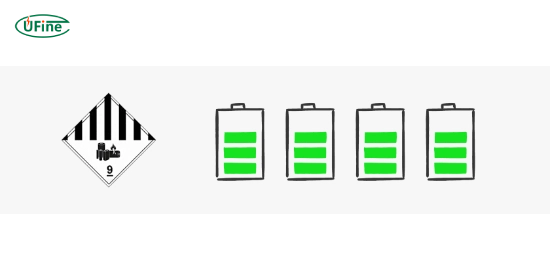What must appear on a lithium battery shipping label to ensure safety and compliance?
To meet global shipping standards, a lithium battery shipping label must include key regulatory markings, such as the Class 9 hazard label, UN number, handling warnings, orientation arrows, and other relevant information.
Shipping lithium batteries isn’t just about putting them in a box—it’s about full compliance with international transport laws. Whether by air, sea, or road, a lithium battery shipping label is essential to safe and legal transportation.
This article will dive deep into the 7 most critical elements of a lithium battery shipping label. These elements ensure your package is appropriately identified, safely handled, and legally shipped. We’ll also cover real-world applications, label types, and compliance tips based on IATA, ICAO, and ADR regulations.
Part 1. What is a lithium battery shipping label?
A lithium battery shipping label is a specialized label for packages containing lithium-ion or lithium-metal batteries. International regulations mandate these labels to inform carriers and handlers about the hazardous nature of the contents.
The purpose of the label is to:
- Ensure safe handling of the package
- Prevent mishandling or accidents
- Provide emergency contact information
- Comply with legal transport requirements
Improperly labeled shipments can result in rejections, fines, legal penalties, or even life-threatening incidents. Correct labeling isn’t just a good idea—it’s a mandatory requirement.
Artikel Terkait: Shipping Lithium Batteries Guide
Part 2. Class 9 hazard label: Identifying dangerous goods
One of the most essential labels is the Class 9 dangerous goods label. This black-and-white diamond-shaped label indicates that the contents of the package fall under miscellaneous hazardous materials, including lithium batteries.
Key features:
- Black stripes on the top half
- A bold “9” at the bottom
- Must be at least 100mm x 100mm in size
The Class 9 label warns that the package needs special handling procedures and may pose a risk during transport. It’s required on most shipments containing lithium batteries that exceed specific thresholds.
Part 3. Lithium battery handling label: Safety warnings
Another required label is the Lithium Battery Handling Label, often seen with shipments classified as UN3481 or UN3091.
What it includes:
- A graphic of a damaged battery with flames
- Text that reads: “Caution: Lithium battery.”
- Proper UN number
- A note to handle with care
- A 24-hour emergency phone number
This label is crucial for alerting handlers about damage, puncture, or overheating risks. It’s also used when batteries are contained in or packed with equipment.
Part 4. UN number: The battery’s official ID
Every lithium battery shipment must display a UN number, which serves as a unique identifier for the battery. It informs regulators and carriers of the exact type of lithium battery contained in the package.
Common UN numbers:
- UN3480 – Lithium-ion batteries (standalone)
- UN3481 – Lithium-ion batteries in or with equipment
- UN3090 – Lithium-metal batteries (standalone)
- UN3091 – Lithium-metal batteries in or with equipment
This number must be shown in uppercase, black text, typically on the handling label or near the shipping mark.
Part 5. Orientation arrows: This way up!
When batteries contain liquid electrolytes or stability is a concern, orientation arrows are required. These red or black arrows indicate the upright position of the package.
Why it matters:
- Prevents leakage of electrolyte
- Reduces the risk of crushing or damage
- Ensures the package is stored and loaded correctly
The label must say “THIS WAY UP” and be placed on at least two opposite sides of the outer package.
Part 6. Limited Quantity label: For small battery shipments
Suppose you’re shipping lithium batteries that fall under limited quantity exemptions. In that case, you may use the Limited Quantity Label instead of the whole Class 9 labelling.
When it applies:
- Batteries shipped under PI966/PI967 (IATA)
- Items that meet ADR II limited quantity thresholds
- Packages that contain only small quantities
The label is a black and white square-on-point symbol that helps streamline the shipping process while still adhering to safety regulations.
Part 7. Cargo aircraft only label: For restricted air shipments
Some lithium batteries—especially those over certain watt-hour (Wh) or lithium content limits—cannot be shipped on passenger aircraft.
You must use the bright orange “Cargo Aircraft Only” label for those.
This label ensures:
- The shipment is only loaded on cargo planes
- Handlers are aware of additional safety requirements
- The package is not mistakenly loaded onto a passenger flight
Ignorance of this rule can result in regulatory violations and pose serious safety risks.
Part 8. Overpack label: For bundled shipment units
When multiple lithium battery packages are placed inside a larger outer container, the package must bear an Overpack Label.
This label must:
- Be marked with the word “OVERPACK.”
- Show that the inner packages are properly labeled
- Be visible and do not obstruct any other required markings
Overpacks are used to protect shipments, but can’t be used to bypass labeling rules.
Part 9. Emergency contact number: Fast response in danger
Lithium battery labels must provide a 24-hour emergency contact number. This is vital if the package leaks or is on fire.
Best practices:
- Ensure the number is operational 24/7
- The contact person should be qualified to provide guidance
- The number should connect to the shipper, manufacturer, or safety officer
This number is usually printed at the bottom of the handling label.
Part 10. Label placement, size, and durability
It’s not just what’s on the label—it’s how you apply it.
Guidelines:
- Labels must be durable, weather-resistant, and visible
- Do not place labels on corners or seams
- Labels must be at least 120mm x 110mm in size
- Use an adhesive strong enough to withstand transport conditions
Incorrect placement can lead to non-compliance fines or package rejection.
Part 11. Do lithium battery labels differ by transport mode?
Yes. Depending on whether you are using air (IATA), sea (IMDG), or road (ADR), the label requirements can differ slightly.
For example:
- Air transport has stricter limits on watt-hours and state of charge
- Sea transport may require a different placement of labels
- Road transport within the EU allows for certain exemptions under ADR rules
Always check the latest version of IATA DGR, IMDG Code, and ADR regulations before shipping.
Part 12. Can you customize lithium battery labels?
Yes, but customization must follow strict compliance:
- You can add company logos, QR codes, or tracking barcodes
- But you cannot alter required elements like UN numbers, hazard symbols, or label sizes
- All custom elements must be secondary to regulatory content
Adding a QR code that links to your SDS (Safety Data Sheet) is a great way to improve traceability.
Part 13. FAQs about lithium battery shipping label
What are the 7 main types of lithium battery shipping labels?
The 7 main types are:
- Class 9 Hazard Label
- Lithium Battery Handling Label
- UN Number Marking
- Orientation Arrows
- Limited Quantity Label
- Cargo Aircraft Only Label
- Overpack Label
What happens if I forget to include one of the required labels?
Forgetting a label can result in:
- Shipment delays
- Fines
- Package being destroyed
- Rejection by airlines or customs
Can I print lithium battery labels at home?
Yes, as long as they meet:
- Size requirements (e.g., 100mm x 100mm)
- Colour and format regulations
- They are printed on durable, waterproof material
Are lithium battery labels standardized across all countries?
No. While IATA, ICAO, and UN recommendations are international, local authorities may have additional rules.
Where can I find the most up-to-date lithium battery labeling regulations?
Check:
- IATA Dangerous Goods Regulations (DGR)
- ICAO Technical Instructions
- ADR (for road transport in Europe)
- IMDG Code (for sea transport)
Related Tags:
More Articles

How to Choose the Right Battery for Blower?
Choosing the right blower battery? Consider voltage, capacity, chemistry & usage. This guide helps match the best battery for peak performance.
How to Choose the Best Insulated Battery Box for Lithium Batteries?
Choosing the Best Insulated Battery Box for Lithium Batteries? Discover key factors such as size, material, and safety for optimal protection and performance.
UN3481 vs UN1323: Classification Guide for Lithium Batteries
UN3481 vs UN1323: UN3481 is for lithium batteries in equipment, while UN1323 covers flammable solids and doesn't apply to batteries.
10000mAh Battery Explained: How Long It Lasts, How It Works
A full guide on 10000mAh li-ion batteries, voltage, usage time, and tips. Discover how a 10000mAh battery works, how long it lasts, and how to choose.
10440 Battery Guide: Size, Voltage, Capacity, Uses & More
Understand 10440 batteries better—size, voltage, safety, and how they compare to AAA. Find the best fit for your high-performance devices.






